 By Bob Currie, Recreational Boating Safety Specialist
By Bob Currie, Recreational Boating Safety Specialist
U. S. Coast Guard Auxiliary Station Galveston Flotilla
In 1838 the United States passed an act requiring steamboats running between sunset and sunrise to carry one or more signal lights. Color and visibility were not specified. In 1846 the United Kingdom passed legislation enabling the Lord High Admiral to publish regulations requiring all sea-going steam vessels to carry lights. The admiralty exercised these powers in 1848 and required steam vessels to display red and green sidelights as well as a white masthead light while under way and a single white light when at anchor. In 1849 the U.S. Congress extended the light requirements to sailing vessels. In 1889 the United States convened the first International Maritime Conference to consider regulations for preventing collisions. The resulting Washington Conference Rules were adopted by the U.S. in 1890 and became effective internationally in 1897.
The Station Galveston Flotilla of the US Coast Guard Auxiliary operates out of the USCG Station Galveston base on Galveston Island. They aid the Coast Guard by providing maritime observation patrols in Galveston Bay; by providing recreational boating vessel safety checks; and by working alongside Coast Guard members in maritime accident investigation, small boat training, providing a safety zone, Aids to Navigation verification, in the galley, on the Coast Guard Drone Team and watch standing.
In 1838 the United States passed an act requiring steamboats running between sunset and sunrise to carry one or more signal lights. Color and visibility were not specified. In 1846 the United Kingdom passed legislation enabling the Lord High Admiral to publish regulations requiring all sea-going steam vessels to carry lights. The admiralty exercised these powers in 1848 and required steam vessels to display red and green sidelights as well as a white masthead light while under way and a single white light when at anchor. In 1849 the U.S. Congress extended the light requirements to sailing vessels. In 1889 the United States convened the first International Maritime Conference to consider regulations for preventing collisions. The resulting Washington Conference Rules were adopted by the U.S. in 1890 and became effective internationally in 1897.
Recreational vessels are required to display navigation lights between sunset and sunrise and other periods of reduced visibility (fog, rain, haze, etc.). Detailed lighting requirements for every description of watercraft are shown in the Navigation Rules. If you have downloaded the Coast Guard app to your smart phone, then you will find a copy of the Navigation Rules on that app. The information provided here is intended for recreational power driven vessels and sailing vessels.
Basic Rules on Boating Navigation Lights
- Running lights (also called sidelights) are required on most all vessels, depending on length. Running lights are red for port and green for starboard, and shine from dead ahead of a vessel to 112.5 degrees aft, on either side. Depending on vessel configuration, the locations of running lights vary.
- Running lights also include the stern light (also called the anchor light), which is always white and, as the name implies, located on the stern. All-round stern lights shine through 360 degrees and must be at least 3.3 feet above the red and green sidelights (now you know why that anchor light pole is so long).
- The running lights must have a separate switch from the stern light. If a vessel is not underway, the running lights should be extinguished and just the stern light should be illuminated. If your running lights are illuminated, this tells other craft that you are underway. Don’t forget to turn your running lights back on when you get underway.
- Powerboats under 65.5 feet are required to show running lights, a stern light, and a masthead light. Combination lights on the bow can be used.
- Vessels between 39.4 and 164 feet must show a white masthead light shining from 112.5 degrees on the port side through dead ahead and to 112.5 degrees on the starboard side. Boats in this category must also display a white stern light shining aft and 67.5 degrees to either side of dead astern.
- Power vessels less than 39.4 feet may show a single all-round light instead of separate masthead and stern lights.
- Sailboats under power are considered powerboats and running lights may be combined into a single bicolor combination light.
- Sailboats under 65.5 feet must show running and stern lights, which may be combined into a bicolor light and stern light, or a single tricolor light at the mast top.
The good news for recreational boat renters is that the Coast Guard has simplified navigation light regulations, which are now focused primarily on vessel length instead of vessel use. Further, the Coast Guard has developed standards for original navigation light equipment installed on boats. Thus, a boat renter can be assured that the location and configuration of navigation lights on a rental are legal for a vessel of its length and purpose. The most important takeaway from this discussion is to make sure your navigation lights work before you depart the dock or launch. You may not plan to be running at night, but you could have reduced visibility such that you would be required to use your navigation lights even during the daytime. Such events include rainstorms and fog.
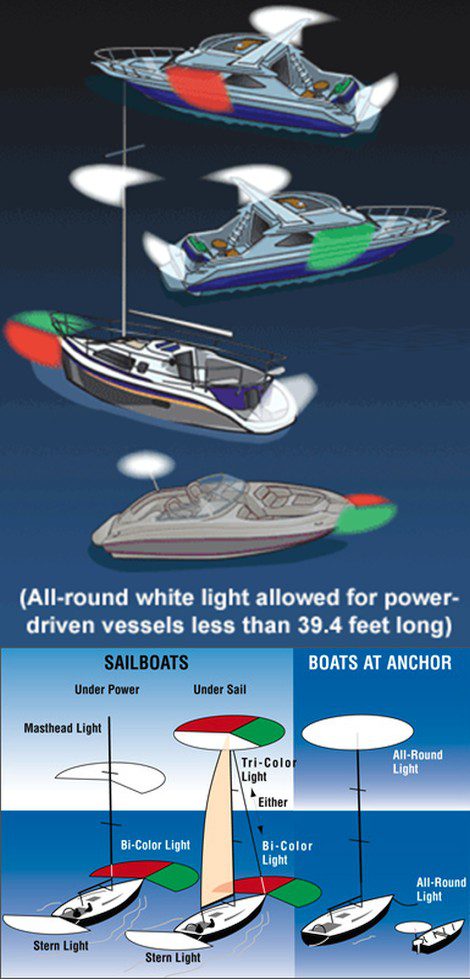
Running at Night
Running at night within a channel or bay is quite an experience. Often all you can see are another boat’s side lights and stern lights, and you have to make decisions based on what little you see. The picture below is one I made in Clear Lake while practicing using radar and AIS. You can see that all the lights along the shore can easily confuse you and stop you from seeing boat traffic between you and the lights. The most important thing you can do is slow down. One of our biggest worries were the numerous crab traps we encountered. A crab trap line wound around your prop shaft can leave you dead in the water unless you have line cutters on your prop shafts.
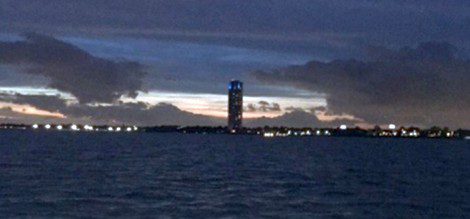
USCG Auxiliary Clear Lake Night Patrol on August 23, 2019
Boating at Night Main Considerations
The main considerations for boating at night are really just extensions of boating in the daytime. First, you want to be able to see where you are going. Second, you want to be seen by other boaters. Third, you don’t want to run into stuff (above or below the water). The third consideration is basically a function of the first two considerations, except that the third consideration also includes avoiding items that are below the waterline. We won’t discuss the weather issue, as that is a column in itself. We will assume that you have done your pre-launch job and determined that the weather and seas are favorable for your nighttime operation. There are three boats operating on the water in the picture above. Can you see them? We could, but only on our radar.
Post a Lookout
Like all living organisms, humans have senses that allow them to move safely within their environment. The two primary senses that sailors use on the water, no matter the time of day or night, are our eyes and ears. The only position on a boat that is required by law is the lookout. Rule 5 of the Rules of the Road says that you must designate someone to watch for dangers that may come from any direction. “Every vessel shall at all times maintain a proper look-out by sight and hearing as well as by all available means appropriate in the prevailing circumstances and conditions so as to make a full appraisal of the situation and of the risk of collision.” Although you may have the latest electronic innovations such as GPS, radar, and infrared, your primary means of avoiding a collision remain your eyes and ears. That said, the rules also state that you must use all means available to avoid a collision, and that includes those electronic devices mentioned above.
Obstructions
We are still talking about our first consideration, which is seeing where you are going. One of the most important things you can do to enhance your ability to see obstructions is to slow down. You do not want to overrun the limits of your vision; that is, you want to be able to stop short of or steer clear of objects you sight in the water. Obstructions above the water include other vessels, land (yes, people run upon land all the time at night), jetties (a vessel with three persons aboard was recently rescued whenever they ran onto the Galveston north jetty), fixed objects such as gas wells (lighted and unlighted) aids to navigation (lighted and unlighted), crab pot floats, and debris in the water. Obstructions below the water include crab pots (that rope that is attached to the float will foul your prop and strand you), submerged pipes, sunken ships (we have MANY in our area), shallow reefs and shoals. Your methods of avoiding such obstructions should include studying an up-to-date chart of the area in which you intend to operate. If you have GPS, be sure to update your chart plotter so that the latest obstructions are included. When you have two lookouts in the daytime, one lookout usually focuses forward and the other focuses on aft observation. At night, you may want to shift their observation to forward on the port side and forward on the starboard side. From experience, I can tell you that on a moonlit night a crab pot float can be seen from about 150 feet away, but not much further. Unlit aids to navigation can be seen about 300 feet away. If the lights on shore suddenly become obstructed, you may be about to run into the side of a barge. That can happen when the tow lights blend into the lights on shore. In keeping with using your eyes and ears, slowing down reduces your own engine noise and allows you to hear that tugboat engine. One of the most important things you can do to maintain your ability to see obstructions is to protect your night vision from stray light.
Night Vision
We use a different part of our eyes to see at night. Night vision is the ability to see in low-light conditions. Many animals that are active at night have an extra tissue layer behind their retina that reflects and intensifies light. Humans do not have this extra tissue layer. Two types of cells within the vertebrate eye are responsible for vision: rods and cones. In dark conditions only rod cells have enough sensitivity to respond and to trigger vision. So at night, half of your ability to see is unavailable. Night vision enhancement is made possible by a combination of two approaches: enhancing spectral range and enhancing intensity range. Night vision equipment that enhances spectral range allows the user to view normally invisible sources of electromagnetic radiation such as infrared and ultraviolet radiation. Equipment that enhances visual intensity achieves this through the use of image intensifiers such as gain multiplication CCD or high sensitivity photodetectors. 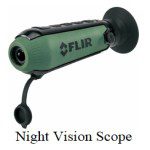 It takes 45 minutes for your eyes to reach maximum night vision once exposed to bright light. It is important for lookouts to avoid bright light 30-45 minutes before assuming a night lookout duty. As the boat operator, you can help maintaining your lookouts’ night vision by avoiding the use of bright lights and turning down your electronic display background lights. As a lookout, if you spend much time looking at a bright display, you will lose your ability to see very far on the water for at least 30 minutes. Handheld infrared night vision scopes (also called thermal vision), such as the one shown here, are now quite affordable to the avid night boater. They allow you to quickly scan ahead. They detect heat signatures as much as 100 yards ahead.
It takes 45 minutes for your eyes to reach maximum night vision once exposed to bright light. It is important for lookouts to avoid bright light 30-45 minutes before assuming a night lookout duty. As the boat operator, you can help maintaining your lookouts’ night vision by avoiding the use of bright lights and turning down your electronic display background lights. As a lookout, if you spend much time looking at a bright display, you will lose your ability to see very far on the water for at least 30 minutes. Handheld infrared night vision scopes (also called thermal vision), such as the one shown here, are now quite affordable to the avid night boater. They allow you to quickly scan ahead. They detect heat signatures as much as 100 yards ahead.
Conduct of Vessels in Restricted Visibility
Rule 19 of the Rules of the Road says that, first, “every vessel shall proceed at a safe speed adapted to the prevailing circumstances and conditions of restricted visibility.” Isn’t that interesting that the rules say that the most important consideration for seeing and being seen is your speed? All vessels are required to maintain a proper lookout, operate at a safe speed for the prevailing conditions (including low light), and remember that any action to avoid collision shall be positive, made in ample time, and with due regard to the observance of good seamanship. In the regard of good seamanship, the crew must know the lights and dayshapes required by the regulations to be displayed by all vessels. A complete and thorough understanding of the lights and dayshapes is crucially important because they tell us the type, size, and direction that a vessel is traveling. This column will discuss the general use of lights. Their use for a particular type of vessel as well as dayshapes is for another discussion. The rules concerning lights shall be complied with from sunset to sunrise, and during such times, no other lights shall be exhibited, except such lights as cannot be mistaken for the lights specified in the rules. The final part of our discussion will be about the Rules of the Road regarding overtaking another boat, passing another boat head-on, and crossing situations.
Overtaking (Rule 13)
Any vessel overtaking any other shall keep out of the way of the vessel being overtaken. A vessel shall be deemed to be overtaking when coming up with another vessel from a direction more than 22.5 degrees abaft her beam; that is, in such a position with reference to the vessel she is overtaking that at night she would be able to see only the stern light of that vessel but neither of her side lights.

Overtaking at Night
When a vessel is in any doubt as to whether she is overtaking another, she shall assume that this is the case and act accordingly. Any subsequent alteration of the bearing between the two vessels shall not make the overtaking vessel a crossing vessel within the meaning of these rules or relieve her of the duty of keeping clear of the overtaken vessel until she is finally past and clear.
Passing Head-On (Rule 14)
Unless otherwise agreed, when two power-driven vessels are meeting on reciprocal or nearly reciprocal courses so as to involve the risk of collision, each shall alter her course to starboard so that each shall pass on the port side of the other.
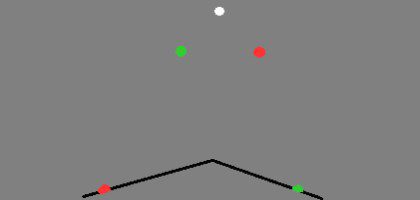
Head-On Situation- side lights and stern light visible
If you can see both side lights and the stern light, you are in a passing head-on situation. There is a chance that you will only be able to see the side lights, but that doesn’t change the situation. There is an old saying about identifying the deadly coral snake: red and yellah- kill a fella. For this situation you could say “green and red- she’s dead ahead.”
Crossing Situations
When two power-driven vessels are crossing so as to involve risk of collision, the vessel which has the other on her own starboard side shall keep out of the way and shall, if the circumstances of the situation permit, avoid crossing ahead of the other vessel.
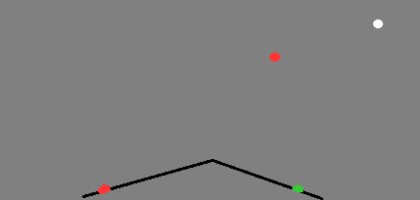
In the situation above, if you see a red side light and a stern light, then you shall keep out of the way of that vessel, crossing behind it if possible. Here the other vessel is off our starboard bow and the crossing rule is in effect. If the red side light and stern light were off our port bow, the crossing situation would be past and we could safely proceed on course.

In the situation above, we see a green side light and a stern light off our port bow. That means we are off the other vessel’s starboard bow, making us the stand on vessel and the other vessel the give way vessel.
Right of Way
Note that nowhere in the Rules of the Road is there any discussion of the concept of right of way. On the water no vessel has the right of way. Instead, there are rules that apply to different situations, and the final word is that if things are not developing as they should under the rules, then you must take any action necessary to avoid a collision. We have only talked about side lights and stern lights. There are several other combinations of all-round lights that indicate such vessel conditions as Not Under Command, Fishing at Night, Trawling at Night, Constrained by Draft, Restricted in Ability to Maneuver, Towing and Pushing, and Vessel Aground. The graphic below illustrates the various possibilities, but the Rules of the Road discussion is for another column.
Summary
When operating at night you must be fully aware of the different light combinations you will see and know how to operate in each case. You must operate at a speed that will allow you enough time to gauge each situation and be able to avoid obstructions besides other boats. Do not display any other lights except those authorized under the rules.
For more information on boating safety, please visit the Official Website of the U.S. Coast Guard’s Boating Safety Division at www.uscgboating.org. Questions about the US Coast Guard Auxiliary or our free Vessel Safety Check program may be directed to me at [email protected]. SAFE BOATING!
[Nov-16-2021]

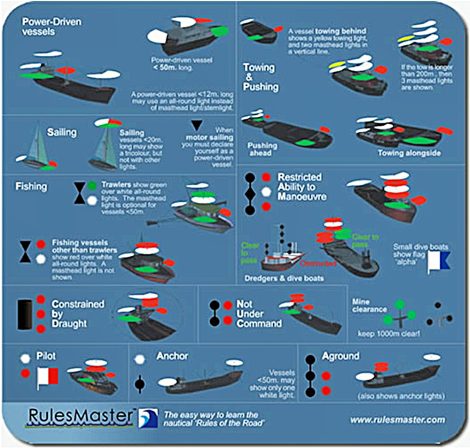
 Posted in
Posted in 
























